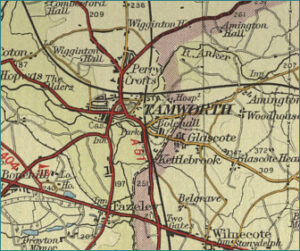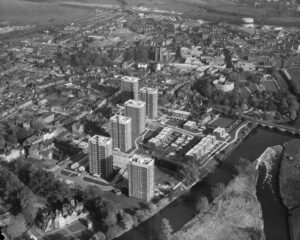By Adam Chapman
May is Local History Month and as such we are delighted to introduce two new volumes in the Victoria County History (VCH) series of big Red Books from Staffordshire and from the East Riding of Yorkshire. To celebrate, in collaboration with our publisher, Boydell & Brewer, we are able to offer substantial discounts on these books, valid until 31 July 2021.
In their different ways the two books demonstrate the value of Local History: by focusing on place from the earliest recorded periods to the ever-moving present, their authors are able to make connections that a period-centred approach might not identify.
The latest volume in the Staffordshire series of the Victoria County History, Tamworth and Drayton Bassett, is the 15th in the set describing this varied Midland county. The town of Tamworth was founded under Æthelflæd, Lady of the Mercians (c. 870–12 June 918) as a burh on the boundaries of the territories that became Staffordshire and Warwickshire in 913. The boundary between those counties ran up the High Street and Æthelflæd may also have installed relics of St Edith in the church there ensuring Tamworth’s church as a centre for Christian worship over a large area. Although a castle was built after the Norman Conquest, its lords did not control the town, which became a corporation under Elizabeth I and is now the head of a district council.

The latest volume in the Yorkshire, East Riding series, Howden:Town and Liberty is the second of two parts of the tenth volume in that series, following the first part, published in 2019. It describes the town of Howden and the accompanying dependent liberty, held by the bishops of Durham until 1836, known as Howdenshire. Here, the bishops used their spiritual authority – gained by control of the early medieval Minster Church at Howden from – to secure secular authority over an expanse of flat, marshy land between the Derwent and Ouse rivers to the west of Hull. The liberty of Howdenshire included all the bishop’s possessions in the East Riding, and the book looks at the liberty’s scattered exclaves across it, offering a full township and parish study of the most important of them, Welton with Melton – birthplace of a 14th century archbishop of York – a distant and detached part of Howdenshire until 1894.
Both volumes place their towns in their wider contexts. Until 1836 Howdenshire was one of the bishop of Durham’s exempt franchises in Yorkshire, enclaves which survived the Reformation and Civil War. Its special nature, which is mostly ancient wetland reclaimed in the twelfth century, is explored via in-depth sections on drainage and river defence, with a reconstruction of the unique medieval and early modern scheme developed to contain the River Ouse and empty the drainage dykes. Although population growth has been less dramatic, and many of the townships that formed Howdenshire have shrunk in the last century, the impact of modern development is apparent in the enormous viaduct of the M62 which carries the road over the river Ouse and the proliferation of windfarms, standing in contrast to the enormous coal-fired power station at Drax across the river. Both are clearly visible from Howden. Part 1 of volume X, Howdenshire: The Townships describes the 19 dependent townships around Howden bordering the two ancient commons of Bishopsoil and Wallingfen associated with Howdenshire. These commons, and their complex systems of management and governance are described in part 2.

Tamworth’s modern development derives from industry. Deposits of coal and clay exploited from the nineteenth century resulted in mining villages at Glascote and Wilnecote in the eastern half of Tamworth parish, which lay in Warwickshire, as did half the town until transferred to Staffordshire in 1890. Other businesses, including the manufacturer of (mostly) three-wheeled cars, Reliant also thrived. The Warwickshire part of the parish was added in 1965 in connection with the decision to take in a Birmingham overspill population, which together with private developments created vast housing estates, the population of “greater Tamworth” more than doubling by the early 21st century.
These two volumes describe contrasting places, but are treated in a similar way that allows us to compare them, using the unique VCH structure. All three volumes benefit from collaboration with local authorities and universities. In the case of Tamworth, the project was supported by the county council and the University of Keele. For Howden, it is the unitary authority, East Riding Council, and the University of Hull.
Take advantage of these introductory offers
VCH Staffordshire XII, Tamworth and DraytonBassett is available to buy from Boydell & Brewer. For more information on the VCH Staffordshire project visit our webpages or follow them on Twitter
* To get a 25% discount enter the code BB913 at the checkout. *
For more information on the VCH Yorkshire, East Riding project, visit our webpages. VCH Yorkshire, East Riding X, part 1 Howdenshire: The Townships and part 2, Howden: Town and Liberty are available to buy from Boydell & Brewer with these very special introductory offers:
* To get a 25% discount on part 2, enter the code BB911 at the checkout. *
* To get a 35% discount on parts 1 and 2 when purchased together, enter the code BB912 at the checkout. *
Dr Adam Chapman is Lecturer in Medieval History and Editor of Victoria County History, part of the Centre for the History of People, Place and Community at the Institute of Historical Research. You can follow him on Twitter.

